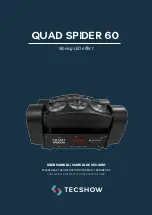
DriveRack
®
DriveRack® 260 User Manual
35
Detailed Parameters
Section 4
LIMITER
Limiter On/Off
Turns the Limiter module on and off.
OverEasy (O) Off to 10
There are ten levels of OverEasy® that can be used for the limiters. The point when the limiter starts to limit is the
“knee.” “Hard knee” limiting is when the limiter starts to reduce the level of a signal abruptly as it passes over the
threshold. OverEasy
®
(soft knee as it is sometimes called) is when the volume of the sound is limited gradually.
OverEasy
®
limiting starts to limit before the level of the signal reaches the threshold and reaches full limiting after the
level has gone above the threshold. This OverEasy
®
limiting, by its very nature sounds much smoother and more natural
and will be used for most applications. When it is gentle (natural sounding or light) limiting that you are looking for,
the limiter offers VariKnee™. VariKnee™ gives you ten levels of OverEasy
®
limiting to choose from (1 being almost hard
knee and 10 being the softest (most gradual) knee). This lets you choose the exact knee that is needed for the dynamic
effect you are looking for. If you are unsure where to set this parameter, a setting of 4 is a great place to start.
Threshold (T) -40 to +20dBu
Threshold is the signal level at which the unit starts to limit the signal. If the level is set to -10 dBu, any signal larger
than -10 dBu is limited while any signal that has a level that is lower than -10dBu is left at the same signal level. Light
limiting is where only the loudest parts of the signal go over the threshold. Very heavy limiting can be achieved by
setting the threshold low enough that almost the entire signal content is over the threshold. For most signals, the most
natural limiting is achieved when most of the signal content remains just below the threshold and only the peaks cross
the threshold.
Auto On/Off/
When auto is turned on, the 260 will override the manual attack, hold and release parameters and continuously adjust
these parameters automatically.
Attack .01 to 200 m Sec (per band or global)
This is the speed at which the 260 limiter starts to limit the signal once it has crossed the threshold. Set the attack time
longer for lower frequency bands, and shorter for higher frequency bands.
Hold 0 to 500 m Sec (per band or global)
Hold is the time the limiter stays in gain reduction after the signal level has dropped below threshold. Hold is useful
when you want the limiter to function for a period of time after it has been triggered. Be careful not to set the hold time
too long as it will not release in time.
Release 360 to 5 dB / Sec (per band or global)
Just like the release time on the compressor, the limiter’s release time controls how fast the limiter releases from gain
reduction after the signal drops below the threshold. Set the release times longer for lower frequency bands and shorter
for higher frequency bands.
P™ On/Off and 1-6
This parameter turns the P limiting on and off. P involves a two-stage process of dynamic limiting. The
first stage of P is the Instantaneous Transient Clamp™ whichclamps the signal with a soft logarithmic clamp
function. This logarithmic function ensures that the signal will not exceed the level set by the P™ OVERSHOOT
control by more than the overshoot amount, and that it will not introduce harsh artifacts. The second stage is a unique
program limiter featuring Intelligent Predictive Limiting™. Its function is to monitor the input signal and intelligently
predict the amount of gain reduction needed to keep the output signal below the ceiling set by the Instantaneous
Transient Clamp™. Note that since the P™ limiter is a fail-safe limiter, it must come after the
OUTPUT GAIN
control.
Summary of Contents for DriveRack 260
Page 9: ...DriveRack DriveRack 260 User Manual 7 Getting Started Section 1 Step by step Setup Procedure...
Page 10: ...8 DriveRack DriveRack 260 User Manual Getting Started Section 1...
Page 11: ...DriveRack DriveRack 260 User Manual 9 Getting Started Section 1...
Page 12: ...10 DriveRack DriveRack 260 User Manual Getting Started Section 1...
Page 13: ...DriveRack DriveRack 260 User Manual 11 Getting Started Section 1...
Page 14: ...12 DriveRack DriveRack 260 User Manual Getting Started Section 1...
Page 15: ...DriveRack DriveRack 260 User Manual 13 Getting Started Section 1...
Page 16: ...14 DriveRack DriveRack 260 User Manual Getting Started Section 1...
















































